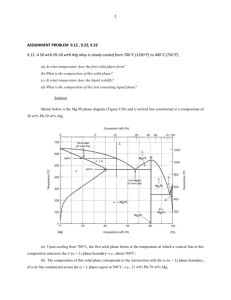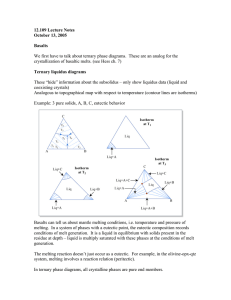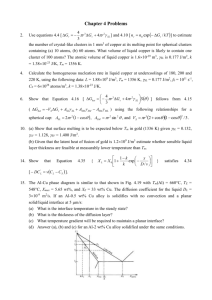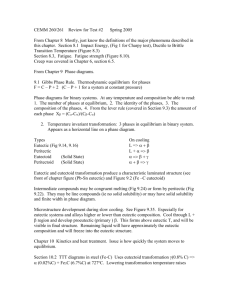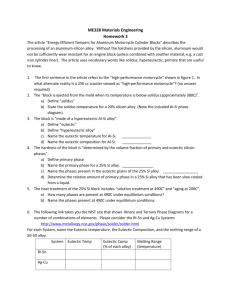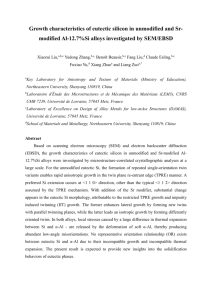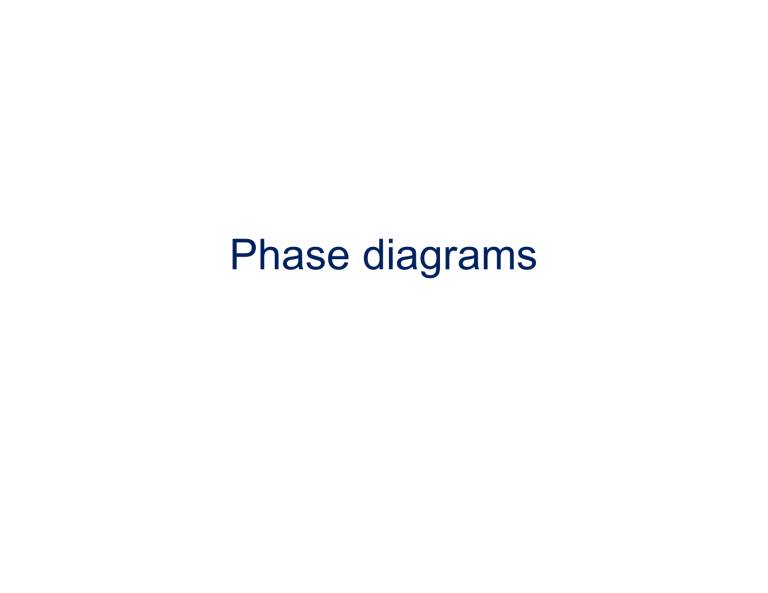
Phase diagrams Phase A phase can be defined as a physically distinct and chemically homogeneous portion of a system that has a particular chemical composition and structure. Water in liquid or vapor state is single phase. Ice floating on water is an example two phase system. Gibbs Phase rule The number of degrees of freedom, F (no. of independently variable factors), number of components, C, and number of phases in equilibrium, P, are related by Gibbs phase rule as F=C–P+2 Number of external factors = 2 (pressure and temperature). For metallurgical system pressure has no appreciable effect on phase equilibrium and hence, F = C – P + 1 Phase Diagrams One component system The simplest phase diagram is the water which is a one component system. It is also known as pressure-temperature or P-T diagram. Two phases exist along each of the three phase boundaries. At low pressure (0.006 atm) and temperature (0.01 C) all the three phases coexist at a point called triple point. Water phase diagram Binary Phase diagrams A binary phase is a two component system. Binary phase diagrams are most commonly used in alloy designing. The simplest binary system is the Cu-Ni which exhibits complete solubility in liquid and solid state. Cu-Ni equilibrium phase diagram Binary Phase diagrams The line above which the alloy is liquid is called the liquidus line. At temperature just below this line crystals of solid solution start forming. The line below which solidification completes is called solidus line. Hence, only solid solution exists at any temperature below the solidus line. The intermediate region between liquidus and solidus lines is the two-phase region where liquid and solid coexist. It can be noted that the two metals are soluble in each other in the entire range of compositions in both liquid and solid state. This kind of system is known as ‘Isomorphous’ system. The Tie line The composition of phases in the two-phase region is not same. To find the composition of the individual phases in the twophase region, a horizontal line (XY), called tie line, is drawn and its intercepts on the liquidus and solidus lines, Cl and Cs, are taken as the composition of the liquid and solid respectively. Lever rule ClCl CoCs XY MX fs The relative fractions of the phases at a given temperature for an alloy composition Co is obtained by the lever rule. This rule gives the fraction of a phase by the ratio of the lengths of the tie line between Co and composition of the other phase to the total length of the tie line. For example, fraction solid, fs is given by CoCl CsCs fl YY MX Similarly fraction liquid, fl Cooling curves Upon cooling from liquid state, the temperature of the pure metal (A or B) drops continuously till melting point at which solidification starts. Solidification happens at a constant temperature (line PQ) as F =0 (F = 1 – 2 +1 = 0). The temperature drops again on completion of solidification. For any alloy (1, 2, 3 etc.) temp. drops till the liquidus (L1, L2, L3). However, in this case, solidification proceeds over a range of temperature as F = 1 (2 – 2 + 1 = 1). Once solidification completes at the solidus (S1, S2, S3) the temp. drops again. Phase diagrams- Limited solubility Not all metals are completely soluble in each other. Distinctions can be made between two types solid solutions with limited solubility – (i) Eutectic and (ii) Peritectic. When the melting points of two metals are comparable, a eutectic system forms while a peritectic results when melting points are significantly different. A eutectic reaction is defined as the one which generates two solids from the liquid at a given temperature and composition, L + Peritectic is Liquid + Solid 1 Solid 2 (L + ) In both the cases three phases (two solids and a liquid) coexist and the degrees of freedom F = 2 – 3 + 1 = 0. This is known as invariant (F = 0) reaction or transformation. Eutectic Phase diagram In the eutectic system between two metals A and B, two solid solutions, one rich in A () and another rich in B () form. In addition to liquidus and solidus lines there are two more lines on A and B rich ends which define the solubility limits B in A and A in B respectively. These are called solvus lines. Eutectic Phase diagram Three phases (L++) coexist at point E. This point is called eutectic point or composition. Left of E is called hypoeutectic whereas right of E is called hypereutectic. A eutectic composition solidifies as a eutectic mixture of and phases. The microstructure at room temperature (RT) may consist of alternate layers or lamellae of and . In hypoeutectic alloys the phase solidifies first and the microstructure at RT consists of this phase (called proeutectic ) and the eutectic (+) mixture. Similarly hypereutectic alloys consist of proeutectic and the eutectic mixture. The melting point at the eutectic point is minimum. That’s why Pb-Sn eutectic alloys are used as solders. Other eutectic systems are Ag-Cu, Al-Si, Al-Cu. Eutectic Cooling curves While cooling a hypoeutectic alloy from the liquid state, the temp. drops continuously till liquidus point, a, at which crystals of proeutectic begins to form. On further cooling the fraction of increases. At any point, b, in the two-phase region the fraction is given by the lever rule as bn/mn. Eutectic Cooling curves Solidification of proeutectic continues till the eutectic temperature is reached. The inflection in the cooling curve between points a and e is due to evolution of the latent heat. At the eutectic point (e) the solidification of eutectic mixture (+) begins through the eutectic reaction and proceeds at a constant temperature as F = 0 (2 – 3 + 1). The cooling behavior in hypereutectic alloy is similar except that proeutectic forms below the liquidus. For a eutectic composition, the proeutectic portion is absent and the cooling curve appears like that of a pure metal. Any composition left of point c or right of point d ( and single phase region respectively) will cool and solidify like an isomorphous system. Peritectic Phase diagram L + . An alloy cooling slowly through the peritectic point, P, the phase will crystallize first just below the liquidus line. At the peritectic temperature, TP all of the liquid and will convert to . Any composition left of P will generate excess and similarly compositions right of P will give rise to an excess of liquid. Peritectic systems – Pt - Ag, Ni - Re, Fe - Ge, Sn-Sb (babbit). Monotectic Phase diagram Another three phase invariant reaction that occurs in some binary system is monotectic reaction in which a liquid transforms to another liquid and a solid. L1 L2 + . Two liquids are immiscible like water and oil over certain range of compositions. Cu-Pb system has a monotectic at 36% Pb and 955 C. Cu-Pd system – Monotectic portion Phase diagrams with intermediate phases Binary system can have two types of solid solutions/phases – terminal phases and intermediate phases. Terminal phases occur near the pure metal ends, e.g. and phases in the eutectic system. Intermediate phases occur inside the phase diagram and are separated by two-phase regions. The Cu-Zn system contains both types of phases. and are terminal phases and , , and are intermediate phases. Intermediate phases form in ceramic phase diagrams also. For example, in the Al2O3 – SiO2 system an intermediate phase called mullite (3Al2O3.2SiO2) is formed. Intermediate phases - Cu-Zn Phase diagram Cu-Zn phase diagram. and are terminal phases and , , and are intermediate phases. Phase diagrams with compounds Sometimes a crystalline compound called intermetallic compound may form between two metals. Such compounds generally have a distinct chemical formula or stoichiometry. Example – Mg2Pb in the Mg-Pb system (appear as a vertical line at 81% Pb ), Mg2Ni, Mg2Si, Fe3C. Mg - Pb phase diagram Ternary Phase diagram A ternary or three component phase diagram has the form of an triangular prism with an equilateral triangle as a base. Pure components are at each vertex, sides are binary compositions and ternary compositions are within the triangle. The composition lines on the triangle is constructed from projections of surfaces. p Wt.% C Ternary phase diagram The temperature varies along the height of the prism. The composition triangle is an isothermal section. Alternatively projections of different surfaces and lines can be shown as temperature contours. The composition of any point in the triangle is determined by drawing perpendiculars from corners to the opposite sides and measuring the distance of the point along the perpendicular. Point p, for example, lies on the isocomoposition line 25% A along the perpendicular A-50. Hence, percentage of A in the alloy is 25%. Similarly B is 50% and C is 25%. Examples Ex.1. A 53% Ni Cu-Ni alloy is cooled from liquid state to 1300 C. Calculate the % of Liquid and solid at 1300 C. Solution: The tie line at 1300 C intersects solidus at 58% Ni and liquidus at 45% Ni. Apply the lever rule to get the liquid fraction % Liquid = 100* (58 – 53)/(58 – 45) = 38% %Solid = 100* (53 – 45)/(58 – 45) = 62% (100 – %Liquid)) Ex.2. A 34.6% Pb-Sn alloy is cooled just below the eutectic temperature (183 C). What is the fraction of proeutectic and eutectic mixture ( +)? Solution: The eutectic point is at 61.9% Sn and boundary is at 19.2% Sn. Apply the lever rule % proeutectic = 100*(61.9 – 34.6)/(61.9 – 19.2) = 64% % ( +) = 100* (34.6 – 19.2)/(61.9 – 19.2) = 36% References 1. M. Hansen & K. Anderko, Constitution of Binary Alloys, McGraw-Hill, 1958 2. ASM International, ASM Handbook Volume 3: Alloy Phase Diagrams, 1992 Web References http://serc.carleton.edu/research_education/equilibria/phaserule.ht ml http://www.sjsu.edu/faculty/selvaduray/page/phase/binary_p_d.pdf http://www.soton.ac.uk/~pasr1/eutectic.htm http://www.ce.berkeley.edu/~paulmont/CE60New/alloys_steel.pdf http://www.substech.com/dokuwiki/doku.php?id=phase_transformat ions_and_phase_diagrams http://www.sjsu.edu/faculty/selvaduray/page/phase/ternary_p_d.pdf Key words Key Words: Phase; phase rule; phase diagrams; isomorphous; eutectic; peritectic; monotectic; intermetallic compound; ternary phase diagram. Quiz 1. Define a phase? What is Gibbs phase rule? 2. What is isomorphous system? Give example of an ispmorphous sytem. 3. Why does a liquid metal solidify at constant temperature? 4. What is a tie line. What is lever rule? 5. How is the liquidus and solidus curves of a binary isomorphous system determined experimentally? (Clue: Refer to the cooling curves) 6. What is an invariant reaction? Give some examples. 7. What kind of system will result when melting points two metals having limited solubility in each other are (i) comparable (ii) significantly different? 8. What is a solvus line? 9. What is eutectic? Why there is infliction in the cooling curve of a hypoeutectic alloy in the two-phase region? Quiz 10. Why does the eutectic reaction happen at a constant temperature? 11. Why Pb-Sn alloys are used as solders? 12. What are terminal and intermediate phases? 13. What is an intermetallic compound? 14. What are the typical phases present in Brass (Cu-Zn)? 15. How is the composition of an alloy determined in a ternary system? 16. What is monotectic reaction? 17. A Pb-Sn alloy contains 64 wt% proeutectic and rest eutectic (+) just below 183 C. Find out the average composition. (Consult Example #2) 18. A 35 wt% Ni Cu-Ni alloy is heated to the two-phase region. If the composition of the phase is 70% Ni find out (i) the temperature, (ii) the composition of the liquid phase and (iii) the mass fraction of both phases. (Consult a Cu-Ni phase diagram)
